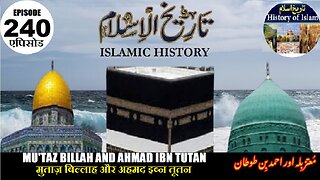Premium Only Content

Banu Amin and the history of his shrine بنو امین کی سوانح عمری اور ان کے مزار کی تاریخ
@islamichistory813 #banuamin #femaleislamicscholars #sufisaint #cultural #heritage #biography #islamic #mysticism #islamic #philosophy #shrine #historical #figures
Biography of Banu Amin and the history of his shrine
Dekhti Aankhooon aur sountay kaanoon ko Asslamoalaikum, sisters, brothers friends and elders, in informative series videos of Islamic Women ascolars, sufisaints, cultural heritages, islamic philosophys, islamic mysticisms and historical women figures. today we are describing biography of Banu Amin and the history of his shrine.
Hajiyeh Seyyedeh Nosrat Begum Amin—universally known as Banu Amin or Lady Amin—was born on Dhul Hijja 26, 1312 AH (June 20,1895 CE) in a devout merchant family in Isfahan, Iran. Her father, Sayyid Muhammad Ali Husayni Isfahani (Amin al?Tujjar), and her mother, Zahra, both hailed from prominent religious lineages. At age thirteen, she married her cousin Haj Mirza Aqa (Mu'inal?Tujjar), with whom she ultimately had eight children, though tragically seven died in childhood due to disease and epidemics.
She began her education at a maktabkhane early and by age eleven was mastering Arabic. By age twenty she was studying advanced religious sciences, including jurisprudence (fiqh), principles of jurisprudence (usul), philosophy, and syntax under scholars such as Abul Qasim Zafarani, Ali Asghar Sharif, and Sayyid Ali Najafabadi—the latter under whom she received her deepest scholarly formation. After twenty three years of rigorous study, in 1354 AH (1935 CE), at age forty, she was granted her first ijazahs: formal permission for ijtihad and hadith narration by Ayatollah Muhammad Kazim Shirazi and Sheikh Abdal Karim Haeri Yazdi—marking her as the first Iranian woman to be officially recognized as a mujtahideh. She later received further authorizations in 1938 from Muhammad Rida Najafi Isfahani.
Lady Amin authored numerous influential works, most notably her monumental Quranic commentary, *Makhzan al-Irfan*, spanning fifteen volumes—making her the only female exegete to write a complete tafsir from beginning to end. Other central works include *Arba‘in al-Hashimiyyah* (forty hadith), *Raveshe Khoshbakhti va Towsiyeh* (ethical guidance), *Al-Nafahat al-Rahmaniyyah* (spiritual inspirations), *Jami‘ al-Shatat* (responses to scholarly queries), *Akhlaq va Rah-e Sa‘adat* (on moral philosophy), and *Seer va Suluk*. Her written legacy combines jurisprudence, mysticism (irfan), ethics, and poetry, reflecting her synthesis of traditional and spiritual sciences.
In 1965, she founded *Maktab-e Fatimah*, a seminary in Isfahan for educating women in Islamic sciences. The school was initially led by her student Zainab al-Sadat Humayuni and later by Hajj Aqai Hasan Imami after 1992. Lady Amin was also politically active—resisting the Pahlavi regime’s unveiling decree and voicing support for Imam Khomeini and the Islamic Revolution in 1979, going as far as publicly praising his Quranic tafsir.
Her leadership resonated far beyond her writings. Numerous male and female scholars, including Ayatollah Marashi Najafi, Allameh Morteza Motahhari, Allameh Tabatabai, and Ayatollah Haeri Shirazi, sought her counsel and spiritual guidance. She also bestowed ijazahs upon students like Sayyid Mar'ashi Najafi and her niece Hashimiyyah al-Tujjar, another noted mujtahideh, as well as Iffat al-Zaman Amin.
Lady Amin passed away on Sha‘ban 30, 1403 AH (June 12, 1983) in Isfahan at the age of 87 and was laid to rest in Isfahan's historic *Takht-e Fulad Cemetery*, a celebrated resting place for the city’s most esteemed scholars and mystics. Her gravesite has become a place where admirers—especially women seeking inspiration—visit to pay respects to her legacy. While it is not a shrine in the traditional Sufi or saintly sense (no elaborate mausoleum was built in her honor), it is honored for its scholarly and spiritual significance.
Her legacy lives on through her writings, her seminary, and the many disciples she mentored. International congresses—such as a planned event in Tehran—continue to commemorate her contributions to Islamic jurisprudence, mysticism, and female religious authority. Though Lady Amin was rooted in tradition, her life redefines the boundaries of female authority in Shi‘a Islam and provides a powerful exemplar of “religious feminism,” using scholarship to uphold women’s dignity and capability within Islamic frameworks.
In sum, Hajiyeh Seyyedeh Nosrat Begum Amin stands as a towering figure: born in 1895 in Isfahan, she became Iran’s first recognized female mujtahideh, authored an unparalleled Qur’anic exegesis, founded an enduring women’s seminary, and passed away in 1983—her tomb at Takht e Fulad a revered testament to her enduring spiritual and intellectual legacy.
With this, we ask for your permission until tomorrow, and tomorrow we will be described biography of Hashimiyyah al-Tujjar and history of her shrine, at the end we pray to Allah Almighty to grant us the abilitty to act on the Quran and Hadith, Amen
Allah Hafiz
=============================
-
 11:12
11:12
ISLAMIC HISTORY
17 hours agoIslamic History Episode 240 Mutaz Billah & Ahmad ibn Tutan मुताज़ बिल्लाह معتز بلہ اور احمد بن طوطان
5 -
 LIVE
LIVE
Lofi Girl
2 years agoSynthwave Radio 🌌 - beats to chill/game to
258 watching -
 25:39
25:39
DeVory Darkins
10 hours ago $13.65 earnedMass shooting erupts in Michigan as bombshell study shows left wing political violence skyrocketed
23.6K97 -
 5:55:33
5:55:33
MattMorseTV
9 hours ago $112.04 earned🔴Portland ANTIFA vs. ICE.🔴
151K311 -
 3:13:00
3:13:00
Badlands Media
23 hours agoThe Narrative Ep. 40: Acceleratia.
59.7K18 -
 6:57:01
6:57:01
SpartakusLIVE
7 hours ago#1 Solo Spartan Sunday || TOXIC Comms, TACTICAL Wins, ENDLESS Content
55K5 -
 49:45
49:45
Sarah Westall
7 hours agoComedians take Center Stage as World goes Nuts w/ Jimmy Dore
37.2K18 -
 3:26:14
3:26:14
IsaiahLCarter
14 hours ago $8.52 earnedAntifa Gets WRECKED. || APOSTATE RADIO 030 (Guests: Joel W. Berry, Josie the Redheaded Libertarian)
47.3K1 -
 4:44:18
4:44:18
CassaiyanGaming
5 hours agoArena Breakout: Infinite Dawg
26.8K2 -
 2:24:32
2:24:32
vivafrei
15 hours agoEp. 284: Ostrich Crisis Continues! Kirk Updates! Fed-Surrection Confirmed? Comey Indicted! AND MORE!
136K206